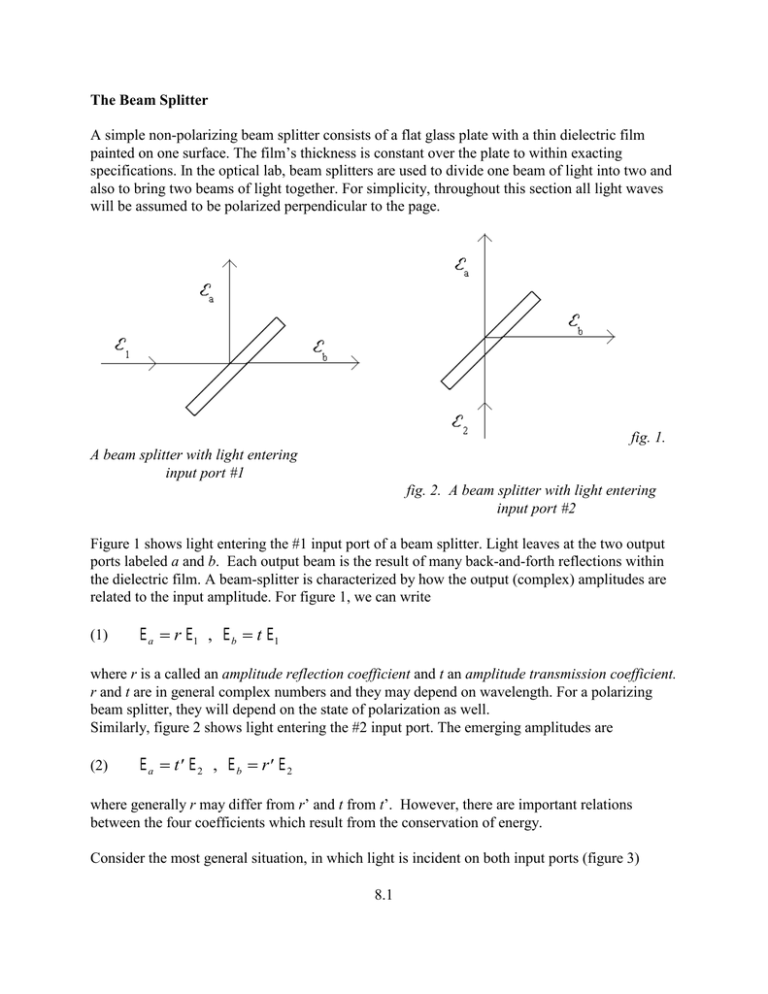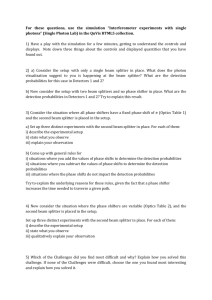A simple non-polarizing beam splitter consists of a flat glass... painted on one surface. The film’s thickness is constant over... The Beam Splitter
advertisement

The Beam Splitter A simple non-polarizing beam splitter consists of a flat glass plate with a thin dielectric film painted on one surface. The film’s thickness is constant over the plate to within exacting specifications. In the optical lab, beam splitters are used to divide one beam of light into two and also to bring two beams of light together. For simplicity, throughout this section all light waves will be assumed to be polarized perpendicular to the page. fig. 1. A beam splitter with light entering input port #1 fig. 2. A beam splitter with light entering input port #2 Figure 1 shows light entering the #1 input port of a beam splitter. Light leaves at the two output ports labeled a and b. Each output beam is the result of many back-and-forth reflections within the dielectric film. A beam-splitter is characterized by how the output (complex) amplitudes are related to the input amplitude. For figure 1, we can write (1) E a = r E1 , E b = t E1 where r is a called an amplitude reflection coefficient and t an amplitude transmission coefficient. r and t are in general complex numbers and they may depend on wavelength. For a polarizing beam splitter, they will depend on the state of polarization as well. Similarly, figure 2 shows light entering the #2 input port. The emerging amplitudes are (2) Ea = t′ E2 , Eb = r′ E2 where generally r may differ from r’ and t from t’. However, there are important relations between the four coefficients which result from the conservation of energy. Consider the most general situation, in which light is incident on both input ports (figure 3) 8.1 figure 3. Light incident on both input ports The relation between input and output is now (3) E a = r E1 + t ′ E 2 , E b = t E1 + r ′ E 2 Assume that there is no absorption of light in the beam splitter. Then the total incident intensity (the sum of the intensities at input ports #1 and #2) will equal the total output intensity. Since the intensities are proportional to the squared modulii of the complex amplitudes, it must be true that 2 2 2 E1 + E 2 = E a + E b (4) = r E1 + t ′ E 2 ( = r +t 2 2 )E 2 2 1 2 + t E1 + r ′ E 2 ( + r′ + t′ 2 2 2 )E 2 2 + 2 Re[( r * t ′ + r ′t*) E1 * E 2 ] Since equation (4) must hold for all possible values of E1 and E2 , it follows that r (5) 2 + t 2 = 1 = r′ 2 + t′ 2 and r * t ′ + r ′t * = 0 These are not the only relations connecting the reflection and transmission coefficients. Another relation follows from expressing E1 and E2 in terms of Ea and Eb . Solving equation (3) for E1 and E2 gives: 8.2 (6) E1 = t′ E b − r ′ E a t E − r Eb , E2 = a tt ′ − rr ′ tt ′ − rr ′ problem 1: Use equation (6) and the first line of equation (4) to deduce that 2 2 2 t + r ′ = tt ′ − rr ′ = t ′ + r 2 and r′ t′ * + r * t = 0 (7) Together, the last lines of each of equations (5) and (7) imply, after a little algebra, that (8) r ′ = r and t ′ = t so that (9) tt ′ − rr ′ = 1 problem 2: Equation (8) says that the primed quantities differ from the unprimed ones only in a phase. Write r = e j sin , r1 = e j sin , t1 = e j cos , t = e j cos . Then show that the above equations imply = + - ± and that = ± - . The results of the above problem imply that the amplitude coefficients are given by three (real) angles, ( , , ) and that (10) jγ jα t ′ r e cos β e sin β = r ′ t −e − j α sin β e − j γ cos β The actual values of the three angles depends on the index of refraction of the film, the angle of incidence of the incoming light, and the thickness of the film. There are many special cases of equation (10). The quantity R r2 is called the intensity reflection coefficient and T t2 is the intensity transmission coefficient. A 50-50 beam splitter is one for which, if there is only a single input beam, the two output beams have equal intensities. This requires = /4 so that R = T = ½ . These are commercially available over a wide range of wavelengths. 8.3 Another special case of equation (10) is the one where all amplitude coefficients are real. This implies that = 0 = so that t1 = t and r1 = - r. A third special case of equation(10) is the one for which t1 = t and r1 = r. For a single incident light beam, the outgoing reflected and transmitted amplitudes have phases which are independent = ± /2 and = 0. The amplitude of the particular input port the light beam enters. For this case coefficients can then be written as t1 = t = cos , r1 = r = ± j sin . We will have occasion to speak of a 50 -50 beam splitter which has t1 = t and r1 = r. This will be called a standard 50-50 beam splitter. This is often used in optical theory because it simplifies analysis. Such a beam splitter is not necessarily readily available commercially. (11) t′ r′ r = t 1 2 j 2 j 2 1 2 standard 50 - 50 beam splitter problem 3: Consider a standard 50 - 50 beams splitter. Let E0 be a real number. What are the output amplitudes when the input amplitudes are A. E1 = E0 , E2 = E0 B. E1 = E0 , E2 = - E0 C. E1 = E0 , E2 = j E0 D. E1 = E0 , E2 = - j E0 8.4







